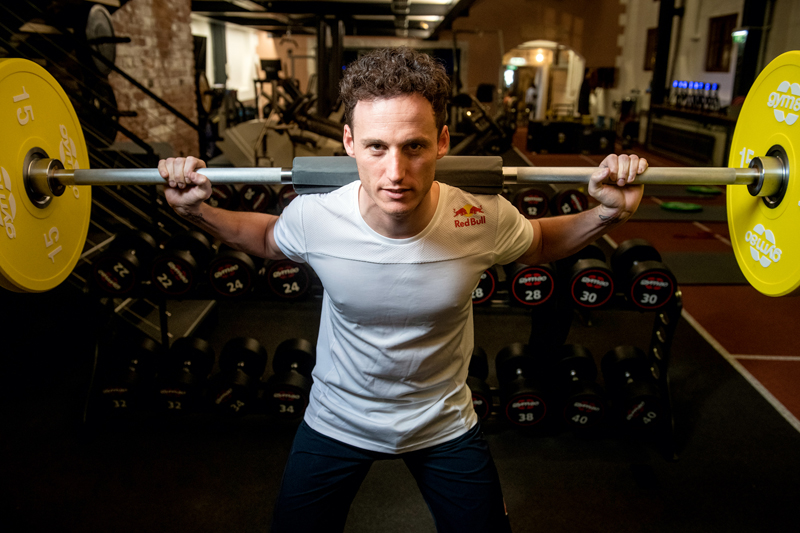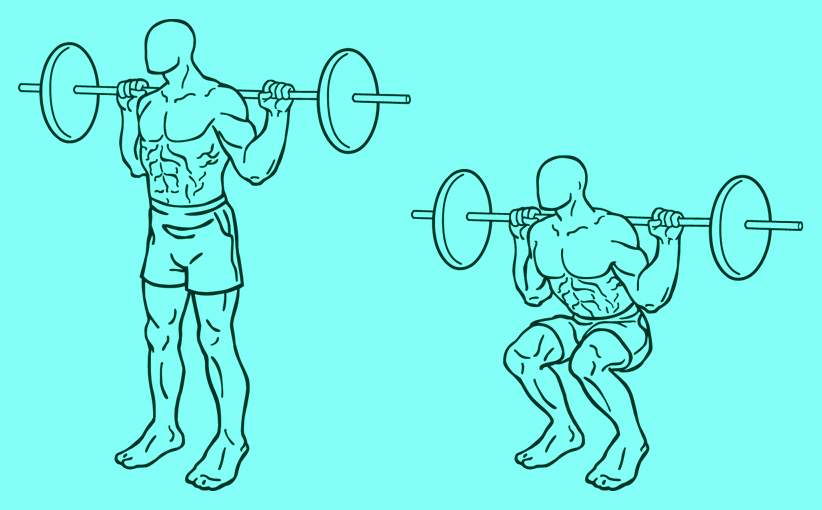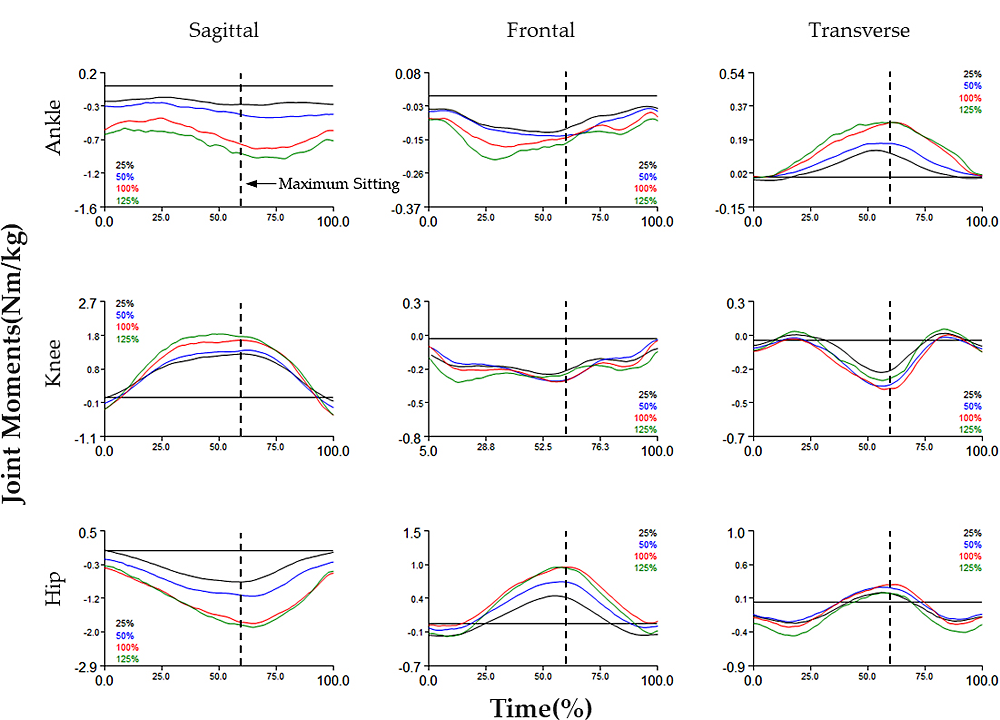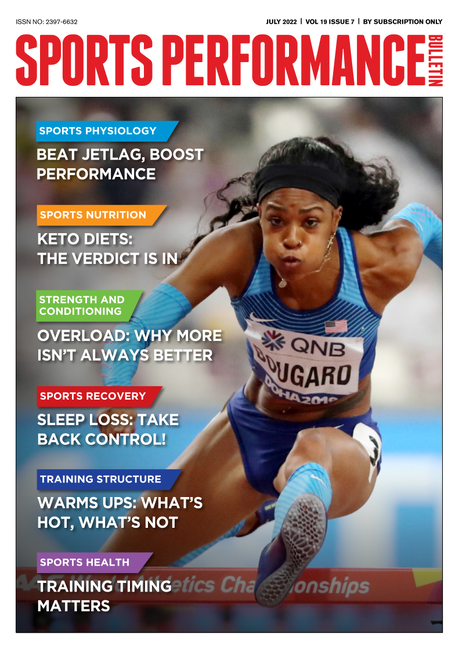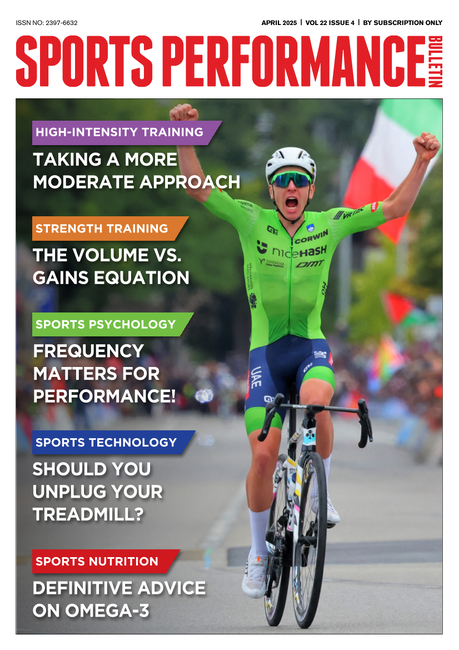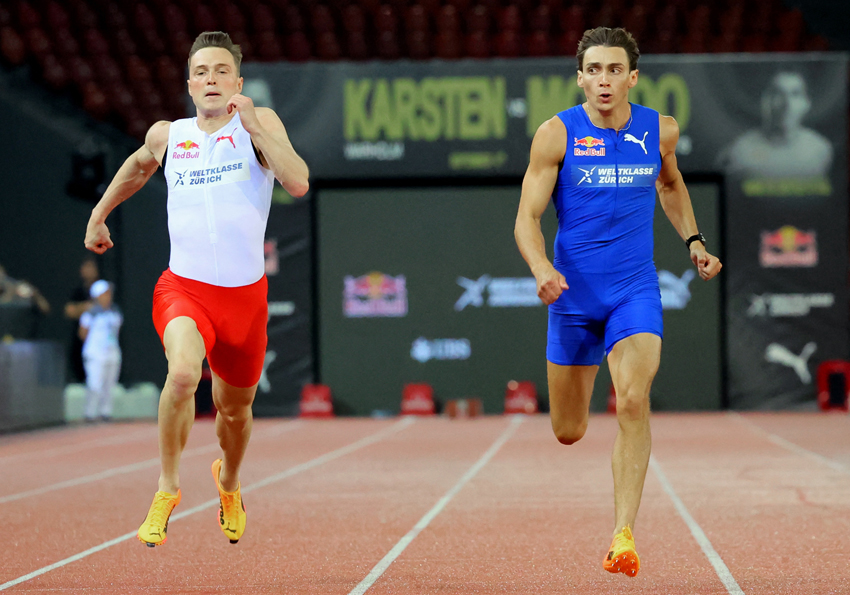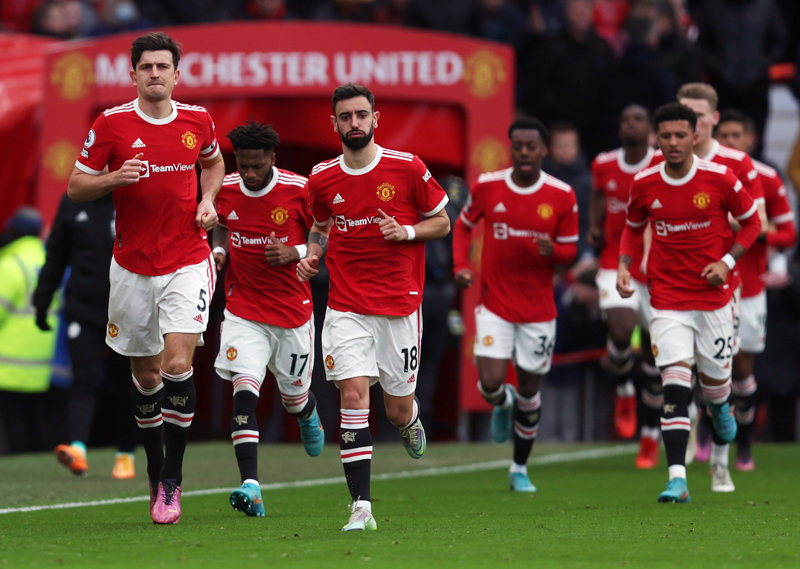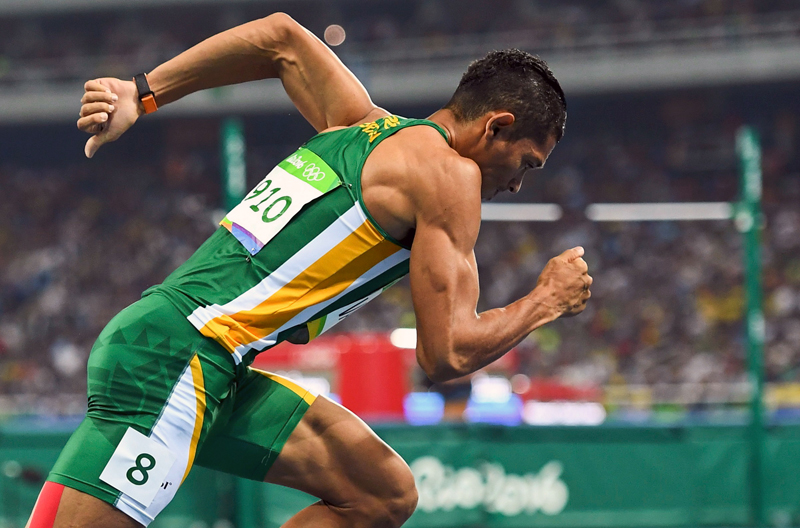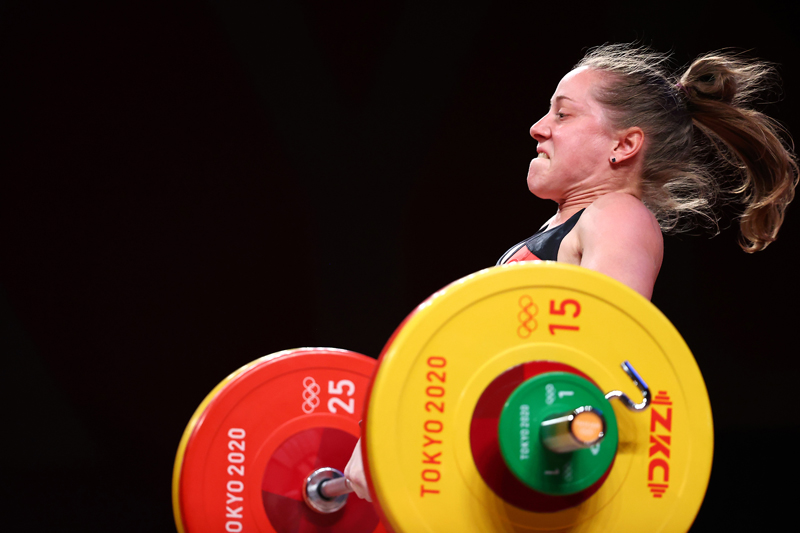You are viewing 1 of your 1 free articles. For unlimited access take a risk-free trial
The king of strength exercises: can it be made loads better?
SPB looks at new research on the science of the squat exercise, and how the loading used can affect the muscle activation outcomes and benefits of the exercise
There are few sports where improving lower body strength doesn’t produce performance gains, which explains why athletes seeking optimum performance often undertake lower limb (ie leg) strength training. And when it comes to this type of strength training, the squat exercise is just about the single most effective strength exercise there is, which is why it is sometimes dubbed the ‘king of exercises’. That’s because it simultaneously targets the largest muscles in the body, including the buttocks, front and rear of the thigh and to a lesser extent, the muscles of the lower back.
Benefits of squats
The powerful electrical stimulation generated by high-intensity squatting is extremely effective at helping to develop power and strength in the leg and buttock muscles, which explains their popularity with sprint and power athletes. However, it turns out that the same type of muscle stimulation can produce significant performance gains for endurance athletes such as runners, cyclists, triathletes, rowers etc too.
Over the last decade or so, evidence has steadily accumulated that performing heavy weight lower body exercises such as squats can benefit both power and endurance performance. For example, studies on cyclists who squat looking at cycling economy (how efficiently the muscles use oxygen to produce power – good cycling economy is a characteristic of all top cyclists) and other attributes of performance have found(1,2):
• Increased cycling economy.
• Increased peak power during incremental tests to exhaustion and longer times to exhaustion.
• More power produced at lactate threshold (4mmol/L).
• Increased average power produced during a 40-minute all-out time trial.
• A better spread of force (torque) applied to the cranks.
The same squat training benefits – ie improved muscle economy and time to exhaustion have also been found in road runners(3), cross-county runners(4) and rowers(5).
Why squats?
Why is the squat exercise rather than equivalent machine exercises such as leg extensions and leg presses the choice of athletes seeking improved leg strength? This is a pertinent question, especially given machine exercises require less skill and technique, are quicker to perform and are supposedly safer. It turns out that the evidence for using squats is actually quite compelling; research shows that compared to machine exercise, free weight squats are superior for increasing knee stability and strength, especially hamstring strength(6). Perhaps even more importantly, the strength developed by performing free weight squats seems better able to translate into the kinds of sports performance gains needed by athletes - for example, the ability to jump high or long(7).
Squat technique
Before we go on to discuss how variations in loading and movement patterns affect squat mechanics, we first need to define what constitutes a good standard technique when performing the squat exercise (see figure 1). Although there are no absolutes in squat technique the consensus among many athletes and coaches (and supported by evidence in the literature) is that squats should performed pretty much as shown in figure 1, with the thighs parallel to ground at the lowest point of the movement (ie between around 100 degrees of knee flexion)(8).
Figure 1: The back squat (standard technique)
Perhaps more so than in any other free weight exercise, the quality of the movement and maintaining strict form during the movement are absolutely essential to success when performing squats. Novices or athletes who are unsure exactly what this entails are strongly recommended to read this article, which provides an in-depth, step-by-step breakdown of how to perform squats with excellent form!
Once the basic movement has been perfected however, there are nuances in technique (most notably the depth of the squat) that can affect how the muscles of the lower limbs are targeted during the exercise. In addition, the loading (weight) used may also impact the activation of the muscles due to increased demands placed on the hips, knees and ankles during the exercise. In reality, squat loading and depth interact to play a combined role in determining how muscles are activated during exercise. This is perhaps unsurprising because we know that the intensity of a squat exercise is determined by the combination of squat depth and weight load(9).
Loading impacts
To date, much has been written about squat depth (also feet and heel position) on muscle activation. But there’s relatively little data on how loading affects activation, so that is what we will focus on from here on. Let’s start with a brand new study on experienced resistance trained men by Korean scientists, which has explored the impact of how weight loading affects the movement patterns during the squat at the hip, knee and ankle joints(10). In this study, the researchers sought to investigate movement pattern changes in the lower extremities as a result of load increases during the back squat exercise, and determine whether there was an association between performing squats and lower extremity injuries.
Eight individuals with experience of squat training were recruited for the study. The subjects performed back squats with loads of 25%, 50%, 100%, and 125% of their bodyweight while being monitored using high definition video and motion detector cameras. Images were taken from several angles and included ground cameras to detect any changes in movement patterns at the ankles. The results showed that as the barbell load increased, posture, form and performance were maintained (which goes to show that strict form can be maintained, even at relatively high weight loadings). However, the rotational moments (forces) experienced by the joints differed according to loading, particularly in the saggital plane (the vertical plane through the middle of the body that divides it into left and right sides - see figure 2).
Figure 2: Changes in joint forces with increasing weight loading
Related Files
Black, blue, red and green plots = 25%, 50%, 100% and 125% of bodyweight loading respectively. 0.0 = start point of squat; dotted line = bottom position of movement; 100.0 = finish of exercise. At loadings over 100% of bodyweight, the ankle, knee and hip joints all increased large increases in forces, especially in the saggital plane (left hand column).
The researchers concluded that their findings showed increased ankle and hip moments (twisting forces) occur to maintain a stable and consistent posture while withstanding increased weight load. This suggests that additional resistance training for the muscles that control the internal and external rotation of the ankle and hip joints should be performed in a training program alongside squats in order to ensure stable squats while maintaining good form. In addition, by using an extrapolation method, the estimated moments for additional weight loads at 150% and 175% of bodyweight were predicted and found to increase dramatically. The researchers therefore cautioned against using loadings in excess of 1.5 times bodyweight in order to avoid injury.
Load and squat depth interactions
The effects on the joints of loading during squatting may not just be down to the weight load used, but a function of the combination of loading and squat depth. A 2020 study looked at peak knee extensor forces at squat depths of above-parallel, parallel, and full depths, and with differing loads of 0 (unloaded), 50, and 85% of 1 repetition maximum (1RM) loading in recreationally active women(11). It found that depth and load had a combined on peak knee forces, and that lower loads at deep squat positions generated equivalent forces at the knee compared to higher loadings at less deep positions.
These findings were replicated by a 2021 study on squats, which found the peak knee extensor forces displayed a depth-by-load interaction such that within each depth, as load increased so did peak force(12); however, within each loading band, the effects of increasing depth were different. In short, it concluded that if knee joint loading is a concern, clinicians or coaches should carefully monitor the depth and load combinations being used.
Heavier loads for glutes and calves
Yet another study on how the combination of loading and squat depth interact with each other looked at the muscular effort in the knee extensors (quadriceps of the frontal thigh) and how it changed as load and squat depth were varied(13). This study found that knee extensor effort increased with greater squat depth but not barbell load, whereas the opposite was found for the calf muscles. Meanwhile for the glutes (buttocks), both greater squat depth and barbell load increased muscle effort levels. Overall, these findings suggested that training for the knee extensors can be performed with relatively low loadings but using a deeper squat position. Meanwhile, heavier barbell loadings are recommended to train the gluteal and calf muscles.
Movement velocity and weight loading
Before we summarize and provide practical recommendations, let’s look at some quite recent research on how loading affects velocity and acceleration patterns when lifting the bar in the upwards phase of squats, especially under heavier loadings. In a study by Norwegian scientists, researchers compared muscle activation and kinematics in free-weight back squats with different loadings(14).
Thirteen resistance-trained males with at least three years experience conducted squats at a range of loadings from 30%-100% of their 1-rep max (1-RM). Importantly, these loads were lifted at high-maximum velocities. While they conducted these trials, the barbell kinematics (movement patterns) and muscle activity of the vastus lateralis, vastus medialis, rectus femoris (key muscles of the quadriceps), semitendinosus, biceps femoris (key muscles of the hamstrings), and gluteus maximus (buttocks) were measured in the upward phase of each load.
With increasing loads, the barbell velocity decreased, the upward phase duration increased, and the peak velocity occurred later. This was to be expected as it’s harder to accelerate heavier loads so velocities will decrease. What was interesting however was while muscle activation increased with increasing loadings, this increase was not linear. In general and with the exception of the heaviest load (1-RM), a similar level of muscle activation in these prime muscle movers was observed for loads between 40% and 60% of 1-RM and between 70% and 90% of 1-RM (see figure 3).
Figure 3: Quadriceps muscle activation during maximal velocity squats at different loadings
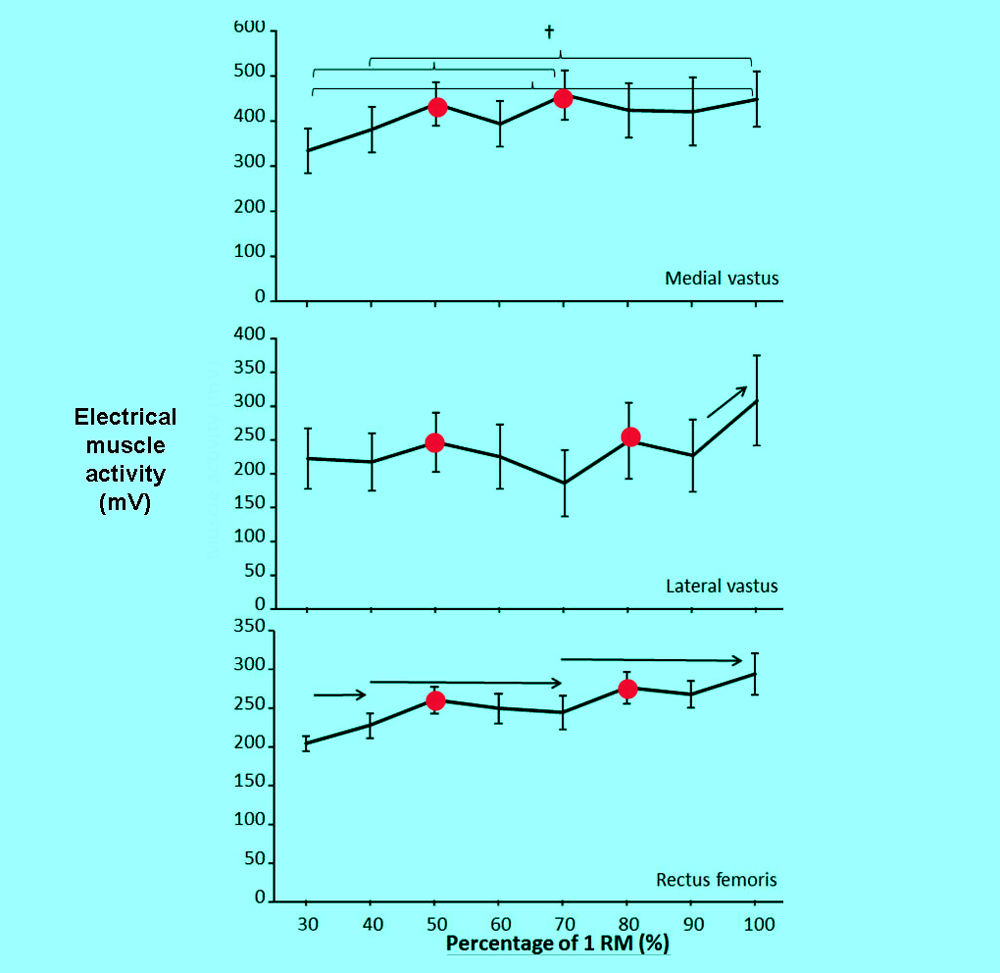
The take home message from these findings is that in most of the muscles activated during squats, maximal lifting velocity may help compensate for decreased loads, which could allow resistance-trained athletes and individuals in rehabilitation to avoid heavy loads but still get the same muscle activation. Therefore resistance-trained athletes can decrease the loading but have similar muscle activity when lifting with maximal velocity.
By decreasing the loading, mechanical stress decreases and recovery time is reduced, which means that using lower loads with maximal lifting velocity may allow athletes to increase the total volume without increasing the risk of injury – particularly relevant for athletes undergoing post-injury rehab. These findings on maximal velocity squat lifts also means that athletes’ preferences (faster, lighter, more or heavier, slower, fewer reps) can be accommodated without significantly affecting the expected benefits.
Putting these findings into practice
There quite a lot to digest here so let’s finish with a bulleted summary of the recent main findings on squat loading and what they mean for athletes engaging in lower-limb strength training:
· Provided you remain focused and your form is strict, increasing your squat loadings does NOT mean that your posture will be negatively affected, even at loadings in excess of 100% of your bodyweight.
· If you use heavier loads (approaching or in excess of 100% of bodyweight) combine your squat training with some ankle and calf training (eg calf raises and the use of a wobble board) and some inner/outer thigh (adductor/abductor) training to improve internal and external ankle and hip rotation strength.
· Athletes should refrain from using squat loadings above 150% of bodyweight due to increased injury risk.
· Consider total loading as a combined effect of squat weight and depth. Where it’s inconvenient or tricky to add a small amount of weight, dropping a couple of inches lower in the squat exercise can generate a small increase in loading.
· Avoid deep squats (below 90 degrees) completely where knee health is a concern.
· If loadings are light, the quadriceps of the frontal thigh can still be activated and effectively targeted by using deeper squats; however, to maximally activate the glutes of the buttock region and the calf muscles, heavier loadings will be required.
· Faster upward squat velocities (with strict form!) at low loadings (50-80% of 1RM) can produce similar muscle activations as using higher loadings. This means, athletes can use higher-velocity training using relatively low loads instead of heavy loading to make good gains. This not only may leave you feeling more refreshed, but is also a preferred strategy when performing strengthening following an injury!
References
1. Strength Cond Res. 2010 Aug;24(8):2157-65
2. Scand J Med Sci Sports. 2015 Feb;25(1):e89-98
3. Med Sci Sports Exerc. 2008 Jun;40(6):1087-92
4. J Strength Cond Res. 2013 Sep;27(9):2619-25
5. Sports Med. 2011 May 1;41(5):413-32
6. Med Sci Sports and Exerc, vol. 30-4 (April), pp. 556-569, 1998
7. J Orthop Sports Phys Ther, Vol. 27-6 (June), pp. 430-435, 1998
8. Med Sci Sports Exerc. 2001 Jan;33(1):127-41
9. Journal of Strength & Conditioning Research. (2002) ; 16: (3): 428-32
10. Technology and Health Care April 2023. Vol. 31, no. S1, pp. 247-258
11. J Strength Cond Res. 2020 Jul;34(7):1945-1952
12. Eur J Sport Sci. 2021 Jul;21(7):976-984
13. J Strength Cond Res. 2012 Oct;26(10):2820-8
14. PLoS One. 2019 May 16;14(5):e0217044
Newsletter Sign Up
Testimonials
Dr. Alexandra Fandetti-Robin, Back & Body Chiropractic
Elspeth Cowell MSCh DpodM SRCh HCPC reg
William Hunter, Nuffield Health
Newsletter Sign Up
Coaches Testimonials
Dr. Alexandra Fandetti-Robin, Back & Body Chiropractic
Elspeth Cowell MSCh DpodM SRCh HCPC reg
William Hunter, Nuffield Health
Keep up with latest sports science research and apply it to maximize performance
Today you have the chance to join a group of athletes, and sports coaches/trainers who all have something special in common...
They use the latest research to improve performance for themselves and their clients - both athletes and sports teams - with help from global specialists in the fields of sports science, sports medicine and sports psychology.
They do this by reading Sports Performance Bulletin, an easy-to-digest but serious-minded journal dedicated to high performance sports. SPB offers a wealth of information and insight into the latest research, in an easily-accessible and understood format, along with a wealth of practical recommendations.
*includes 3 coaching manuals
Get Inspired
All the latest techniques and approaches
Sports Performance Bulletin helps dedicated endurance athletes improve their performance. Sense-checking the latest sports science research, and sourcing evidence and case studies to support findings, Sports Performance Bulletin turns proven insights into easily digestible practical advice. Supporting athletes, coaches and professionals who wish to ensure their guidance and programmes are kept right up to date and based on credible science.
